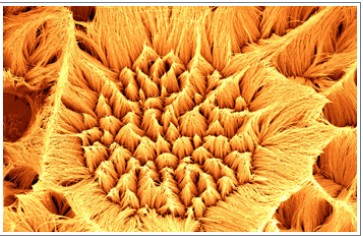Apr
5
A New Fuel Cell Design Makes the Cover
April 5, 2011 | 1 Comment
The April issue of American Chemical Society’s Nano features the Yale School of Engineering & Applied Science new fuel cell catalyst system using nanowires made of a novel material that boosts long-term performance by 2.4 times compared to today’s technology. That’s a big boost dearly needed for fuel cells.

Pt-BMG Nanowires Array for Fuel Cells. Click image for the largest view. Image credit Golden Kumar and Miriam Schroers.
One reason (other than cost) fuel cells aren’t widely adopted is their lack of endurance. The catalysts used in today’s state-of-the-art fuels cells break down over time, inhibiting the chemical reaction that converts fuel into electricity. Additionally, current technology relies on small particles coated with the catalyst; but the catalyst particles’ limited surface area means only a fraction of the catalyst is available at any given time.
Fuel cells have the promise to be a cleaner and far more efficient solution to the future’s energy production needs, with potential applications in everything from small electronics to over the road vehicles. The potential could get to powering airplanes – the light weight potential and efficiency are very strong draws for research.
Yale engineers Jan Schroers and André Taylor have developed miniscule nanowires made of an innovative metal alloy known as a bulk metallic glass (BMG) that have high surface areas, thereby exposing more of the catalyst to the fuel. The catalyst in the nano wire support also maintains its activity longer than traditional fuel cell catalyst systems.
In comparison current fuel cell technology uses carbon black, an inexpensive and electrically conductive carbon material, as a support for platinum catalyst particles. The carbon transports electricity, while the platinum is the catalyst that drives the production of electricity. The more platinum particles the fuel is exposed to, the more electricity is produced. Here’s the problem – carbon black is porous, so the platinum that locates to the inner pores may not be exposed. Then add in that carbon black also tends to corrode over time.
Taylor points this out saying, “In order to produce more efficient fuel cells, you want to increase the active surface area of the catalyst, and you want your catalyst to last.”

Pt-BMG Nanowires for Fuel Cells Closeup. Click image for the largest view. Image credit Schroers and Taylor
The Yale team is using a compound of Pt57.5Cu14.7Ni5.3P22.5 for the bulk metallic glass (Pt-BMG) and usies a facile and scalable nanoimprinting approach to build the nanowires. That creates a dealloyed high surface area nanowire catalyst with high conductivity and activity for methanol and ethanol oxidation. That’s right – the common alcohols ethanol and methanol.At 13 nanometers in scale (about 1/10,000 the width of a human hair), the Schroers and Taylor Pt-BMG nanowires are about three times smaller than carbon black particles. The nanowires’ long, thin shape gives them much more active surface area per mass compared to carbon black. In addition, rather than sticking platinum particles onto a support material, the Yale team incorporated the platinum into the nanowire alloy itself, ensuring that it continues to react with the fuel over time.
After 1000 cycles, these nanowires are maintaining 96% of their performance, some 2.4 times as much as conventional platinum carbon (Pt/C) catalysts. These properties make the Pt-BMG catalyst an ideal candidate for widespread commercial use such as for energy conversion/storage and sensors. Technically one question jumps out, just how recyclable is the nanowire catalyst? The platinum is very expensive. Endlessly recycling the whole of the active part of a fuel cell would have a huge impact on the ability to build market.
Schroers explains it’s the nanowires’ unique chemical composition that makes it possible to shape them into such small rods using a hot-press method. Schroers has developed other BMG alloys that can also be blow molded into complicated shapes. The Pt-BMG nanowires also conduct electricity better than carbon black and carbon nanotubes, and are less expensive to process. That suggests less electrical resistance heat buildup and lower manufacturing costs.
So far Taylor has tested the Pt-BMG catalyst system for alcohol-based fuel cells (including those that use ethanol and methanol as fuel sources), but the team says the system could be used in other types of fuel cells.
“This is the introduction of a new class of materials that can be used as electrocatalysts,” Taylor said. “It’s a real step toward making fuel cells commercially viable and, ultimately, supplementing or replacing batteries in electronic devices.”
The ACS Nano paper authors also include Marcelo Carmo, Ryan C. Sekol, Shiyan Ding and Golden Kumar (all of Yale University).
Last week saw another take on fuel cell development. One hopes these various teams are looking at each other’s papers and thinking about how to get the various very good ideas to work together. Then maybe the fuel cell market can get somewhere more mass in scale and build up some industrial infrastructure.
Meanwhile more information would be useful. Press releases and paper abstracts are fine, but if this is as good as its implied, costs and outputs need much more disclosure.
Comments
1 Comment so far


how make design for solid oxide fuel cell to product 100 MW